SigC5561-7x7-PTMC VoIP Card
VoIP Blade for VoIP, DSP Farm and Echo Cancellation Applications
VoIP PCI/PCIe Card for Blade Server Applications
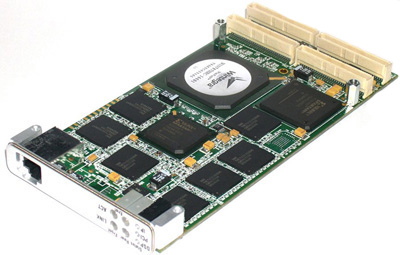
SigC5561-7x7-PTMC card, view of front bezel and bottom side. Card dimensions are 149 x 74 mm. |
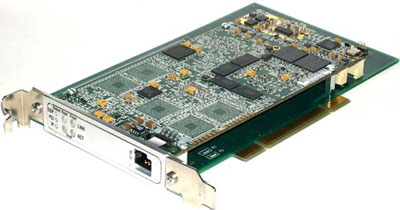
SigC5561-7x7-PTMC configured as PCI VoIP card for blade server |
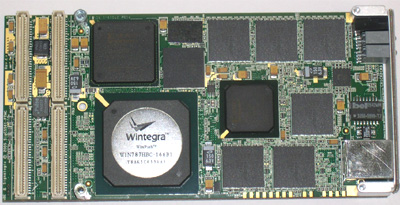
Bottom view of SigC5561-7x7-PTMC card with (7) TNETV3010 DSPs and WinPath 7x7 network access/packet processor populated. Also shown are front panel 10/100 circuitry and location for NAND Flash. |
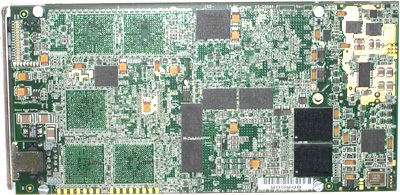
Top view of SigC5561-7x7-PTMC card, showing NOR Flash, GbE PHY, host memory, packet memory, and parameter memory devices for the WinPath network processor. |
- Overview
- VoIP Overview
- VoIP Feature Summary
- IP Protocol Feature Summary
- TDM Protocol Feature Summary
- ATM Protocol Feature Summary
- General Feature Summary
- TNETV3010 Processor Family
- WinPath Processor
- Block Diagram
- Software Support
- Specifications
- cPCI Carrier Card
- Desktop PC
- Carrier Card Option: HW400c/2
- Channelized T3 Interface Option: wanT3
- Frequently Asked Questions
- Host Media Processing
- Network Configuration Examples
- Server Configuration Examples
- SigIMS IMS Platform
Overview
The SigC5561-7x7-PTMC card condenses the Texas Instruments / Telogy high-density VoIP reference design -- including DSP farm and network processor -- into PMC form-factor, while still providing OC3 channel capacity. Miniaturization to PMC form-factor allows the SigC5561-7x7-PTMC card to be run as a stand-alone media gateway, PCI VoIP card for open source VoIP applications, or combined with standard, off-the-shelf cPCI, ATCA, and VME carrier cards to form single-slot "VoP Server Blade" media gateway and softswitch solutions in infrastructure embedded systems. targeted at VoP (voice-over-packet) gateway and soft-switch applications, the SigC5561 is powered by Texas Instruments TNETV3010 devices, each containing six (6) C5561 cores, to provide fully Telogy-compliant voice software operation. The SigC5561-PTMC can scale from 192 to 2304 carrier grade voice channels (PCM speech, or G.711), 96 to 1152 G.729AB, and 72 to 864 G.723 or GSM-AMR codec channels The run-time ratio of G.711 to Lbr channels may be controlled dynamically, on as-needed basis, by host software. The overall result is a highly scalable, small form-factor VoIP card solution. The SigC5561 includes a Wintegra 7x7 WinPath network access processor, to provide OC3 access to a variety of interworking and IP protocols. The WinPath is connected directly to the DSP farm using high-speed Utopia interface, and is also accessible to host software over the PCI bus. Other card solutions on the market require non-standard "mezzanine card" combinations, dual slots, or other card combinations to reach OC3 channel capacity. In contrast, the SigC5561 takes a strictly standards- based approach, with full compliance to IEEE 1386.1 (PMC) and PICMG 2.15 (PTMC) standards. The SigC5561 card provides flexible network I/O, includes all necessary oncard power generation, is not over-wide, and does not require additional basecard connectors beyond the PMC standard. By using power efficient Texas Instruments VoIP chips, the SigC5561 card does not require per-chip heatsinks that exceed IEEE and PICMG height restrictions, and does not require costly, specialized airflow engineering in the chassis. By maintaining full PMC and PTMC compliance, the SigC5561-7x7-PTMC card is a PMC form-factor card. It includes all necessary oncard power generation. The card is compliant with IEEE P1386.1 (PMC) and PICMG 2.15 (PTMC) standards, usable with a wide range of cPCI, ATCA, VME, and other host platforms, including:- cPCI (compact PCI)carrier card
- ATCA (Advanced Telecom Computing Architecture) card
- VME carrier card
- desktop PCI/PCIe, using PMC-to-PCI/PCIe adapter
- stand-alone, with 5V and 3.3V power
- PMC form-factor card, compliant with PICMG 2.15 (PTMC) electrical specifications and IEEE 1386.1 (PMC) mechanical specification
- DSP Farm with up to twelve (12) TNETV3010 DSPs running at 300 MHz each
- WinPath 7x7 network access processor, including packet data SDRAM, parameter ZBT SSRAM, and host bus SDRAM to allow the WinPath to operate up to OC3 channel capacity
- supports PTMC configurations 2, 3, and 5
- high-performance PCI-to-HPI16 interface allows host communication direct to DSP memory while real-time applications continue to run
- TDM interface with up to 4096 time-slots
- GbE interface, with network switch connection to DSP Farm
- 10/100 front-panel interface with RJ-45 connector
- high capacity, low-noise oncard power generation
VoIP Overview
In a typical VoIP or VoATM application, the SigC5561-PTMC processes TDM channels of 64 kbps PCM (G6711) voice, fax or data traffic. Voice data is optionally compressed by Telogy Software via GSM, G.726 (ADPCM), G.729AB or other Lbr codec. In addition, Telogy voice Software provides RTP, RTCP, and T.38 packetization of voice and fax data, and a comprehensive range of voice and data telephony functions. The WinPath processor provides packet formatting, segmentation, reassembly, and routing functions for the standard PTMC network interfaces. A 32-bit PCI bus interface allows Linux or other system software residing on the carrier card to control the SigC5561-PTMC module, and enable support for a wide range of telephony and protocol software stacks, including SIP, H.323, MGCP, and Megaco.VoIP Feature Summary
| Voice Compression (CODEC) |
G.711 (64 kbps m-law or A-law) G.722 wideband (48, 56, 64 kbps) G.723.1 (24, 40 kbps) G.723.1A G.726 ADPCM (16, 24, 32, 40 kbps) G.727 ADPCM G.728 (16 kbps) G.729 (8 kbps) G.729AB (8 kbps) G.729D (6.4 kbps) G.729E (11.8 kbps) GSM FR, GSM EFR, GSM AMR EVRC SMV iLBC QCELP13 FAX T38U CID CONF |
| Echo Cancellation |
G.165 and G.168 64 msec nominal. Up to 128 msec with multiple reflection cancellations; includes Telogy proprietary enhancements |
| Jitter Buffer | Packet playout unit; Telogy packet-loss mitigation options |
| Silence Suppression |
VAD, CNG, Telogy proprietary G.723.1A G.729AB GSM FR GSM EFR |
| Fax Relay / Pass-Thru: |
T.38 TCP/IP FRF.11 AAL2 I.366.2 V.17 @ 7.2, 9.6, 12, 14.4 kbps V.27ter @ 2.4, 4.8 kbps V.29 @ 7.2, 9.6 kbps T.30 |
| Modem Relay / Pass-Thru: |
V.92 V.90 V.34 V.32bis V.22bis V.21 V.23 Bell 212, 103 V.42 MNP 2-4, V.44 MNP 5 Modem transparency: auto-switch from G.7xx to G.711 on fax or modem detection |
| ISDN |
Sync-mode PPP, HDLC framed PPP V.110 56k rate adaptation |
|
VoIP Standards Compliance |
RTP RTCP per RFC 1889/1890/2508 UDP/IP header |
|
VoATM Standards Compliance |
AAL0 (raw cell) AAL1 AAL2 I.366.2 |
| In-Band Signaling / Call Processing | DTMF, MF R1, MF R2, MFC, SS7 COT, SF, Call Progress for T1 CAS |
| Out-of-Band Signaling/Call Processing | DTMF Relay (RFC 2833) |
| Network Packet Switching | Example: G.729AB / RTP G.726 / AAL2 |
| Rx, Tx Gain Control | Programmable ±31 dB |
| Packet Aggregation and Processing |
Running default Control Path Software (CPS) and Data Path Software (DPS) builds, the WinPath 747 or 787 Communications and Network Processor provides:
|
| Development Tool and Software Packages | VDS, DirectdSP, Hypersignal-Macro, C55xx Source Code Interface, Texas Instruments Code Composer Studio |
IP Protocol Feature Summary
- IP Termination -- Support for IPv4 (including TOS, TTL, Header processing)
- IP Routing -- Support for IPv4, RFC 1812 (including TOS, TTL, Header processing)
- IP Interworking
- Per flow WFQ and shaping
- Routing and forwarding over ATM (RFC 1483/2684)
- IP routing and forwarding over PPP (RFC 2364/2472) and PPP-Mux (RFC 1661)
- Supports IPv4 IP routing and forwarding over Ethernet (RFC1042)
- IP Classification -- Supports Multi-field classification and Differentiated Services according to RFC 2474 and 2475. Algorithmic with single or multiple passes without external
- IP Address Resolution -- Supports full Longest Prefix Match (LPM) L2 Ethernet switching using MAC address or 802.1P/Q VLAN tags
- bridging--Ethernet to Ethernet or Ethernet to ATM
- Direct Mapping -- from ATM VC to Ethernet port or PPP port
- PPP and ML-PPP -- Supports PPP (RFC 1661), ML-PPP (RFC 1990), PPP-Mux and HDLC. ML-PPP supports 1 to 32 ports
- MPLS -- Tagging and detagging
- Statistics -- Extensive collection at the channel and flow
TDM Protocol Feature Summary
- CESoPSN (TDMoIP)
- iTDM
ATM Protocol Feature Summary
- ATM Adaptation layers AAL0, AAL1, AAL2 and AAL5
- ATM traffic shaping for Cbr, Vbr, GFR and Ubr, Compatibl with ATM Forum TM-4.1
- Up to 64K simultaneous ATM channels (VC or VP) with per-VC queuing
- ATM cell and CPS switching up to 622 Mbps full duplex
- AAL1 -- Supports structured and unstructured Circuit Emulation Services (CES 2.0) ATMF-0078.
- IMA -- Inverse Multiplexing over ATM in one or more IMA groups according to ATMF 0086.001
- bridging -- Ethernet to Ethernet or Ethernet to ATM
- Direct Mapping -- from ATM VC to Ethernet port or PPP port
- MPLS -- Tagging and detagging
- Statistics -- Extensive collection at the channel and flow
General Feature Summary
Below is a general feature summary for the SigC5561-PTMC card.- up to twelve (12) TNETV3010 devices, capable of 192 G.711 channels per device
- WinPath 7x7 network processor, including packet data memory, parameter memory, and host bus memory
- host interface between PCI and MIPS core software running on the WinPath
- Optional configuration with no WinPath and DSP farm output UDP/IP packets routed directly to GbE interface
- supports PTMC configuration 2 (2560 TDM time-slots), configuration 3 (2560 TDM time-slots, RMII interface, UTOPIA interface), configuration 5 (4096 TDM time-slots, GbE interface (no transformer)
- front-panel 10/100 interface (RJ-45)
- 8 or 16M x 8 boot Flash EEPROM, also available for non-volatile data storage
- 128M x 8 NAND Flash EEPROM, for streaming media data storage
TNETV3010 Processor Family
The SigC5561-7x7-PTMC card contains Texas Instruments TNETV3010 devices, a member of TI's popular TNET family of DSP devices, targeted at VoP applications. The TNETV3010 offers high performance, ultra low power consumption compared to other VoIP chips, and extremely small size and footprint. The SigC5561-7x7-PTMC card contains a "DSP Farm" area that may be populated with one (1) to twelve (12) TNETV3010 devices. Each TNETV3010 device contains six (6) C5561 300 MIPS cores with dual parallel multiplier, or 3600 total MIPS processing capability. Each individual C5561 core includes a complete set of peripherals, including synchronous TDM serial ports, host/network data ports, timers, DMA channels, and 64k x 16 of fast, local SRAM. In addition, each TNETV3010 device contains 512k x 16 of 6-way shared SRAM (shared between all C5561 cores), and onchip PLL providing clock configuration and control. Texas Instrument's advanced, in-house IC fabrication process is key to producing the small package size and low power consumption necessary to allow a high channel density solution that meets module chip-height restrictions and required no heatsink to other competing voice chip solutions. Note that number of TNETV3010 DSP devices populated on the SigC5561-7x7-PTMC is variable depending on channel capacity requirements and cost constraints, depending on the application.WinPath Processor
The WinPath device from Wintegra combines a MIPS Core based "control plane" with an ASIC-like "data plane" to form a powerful network access / packet processor. The data plane layer allows wire-speed forwarding of packets between a wide range of peripherals, including UTOPIA and GbE. The WinPath runs WindRiver's VxWorks operating system and libraries and drivers provided by Wintegra and Telogy on the MIPS Core. Application layer programming is also possible on this device, for example to add application-specific IP-to-IP processing features.Block Diagram
Below is a block diagram for the SigC5561-7x7-PTMC card.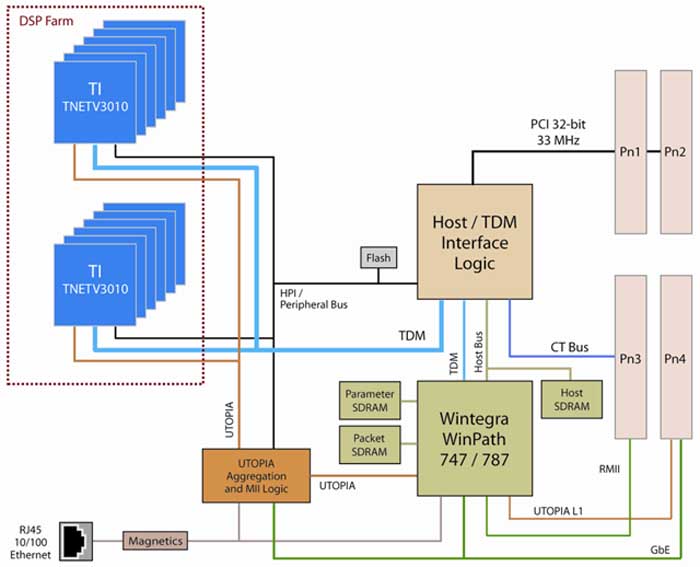
Software Support
The SigC5561-PTMC card is fully Telogy software compliant, supporting a wide range voice and wireless real-time algorithms. Telogy software is used widely in VoP infrastructure, including a number of Tier 1 providers. In addition to Telogy voice software, SigC5561 card software support includes:- DSPower Media Gateway and transcoding Server (MGTS) software
- DirectdSP API
- WinXP and Linux drivers
- Card component that runs on the WinPath network processor
- Host processor component
- Linux -- PowerPC or desktop
- WinXP, Win2k, Win9x
Specifications
Below are preliminary specifications for the SigC5561-PTMC card. All specifications are subject to change.| Form Factor |
Single wide PCI-mezzanine, PT5MC (opt. for PT2MC or PT3MC) IEEE P1386/P1386.1, PICMG 2.15 |
|
| PTMC Configurations |
PT5MC (standard): 32-ch CT Bus (Pn3); Gigabit Ethernet (Pn4) PT2MC (OEM opt.): 20-ch CT Bus, RMII (Pn3) PT3MC (OEM opt.): 20-ch CT Bus, RMII (Pn3); UTOPIA L1 (Pn4) |
|
| DSP Farm |
Up to 12 Texas Instruments TNETV3010 devices with Premium Carrier Grade Telogy Software; includes indemnification of essential patents for conformance & interoperability |
|
| Network Processor | Wintegra WinPath Access Packet Processor | |
| PCI Bus Interface | 1.8V / 3.3V signaling with passive adapter, 5V signaling with active adapter | |
| Power Comsumption | 15W in 2 DSP configuration 16W in 7 DSP configuration 23W in 12 DSP configuration | |
| Temperature | Operating: | 0șC to 55șC (airflow >200 LFM) |
| Storage: | -40șC to 85șC | |
| Humidity | Operating: | 10 to 90% non-condensing |
| Storage: | 5 to 95% non-condensing | |
| Designed to Meet |
FCC Part 15 Subpart B EN55022 EN55024 UL60950 3rd edition UL60950 3rd edition |
|
cPCI Carrier Card
Below is a picture showing the SigC5561-7x7-PTMC used with the HW400c/2 carrier card from One Stop System. The SigC5561 is inserted into PTMC site #1 on the HW400c/2: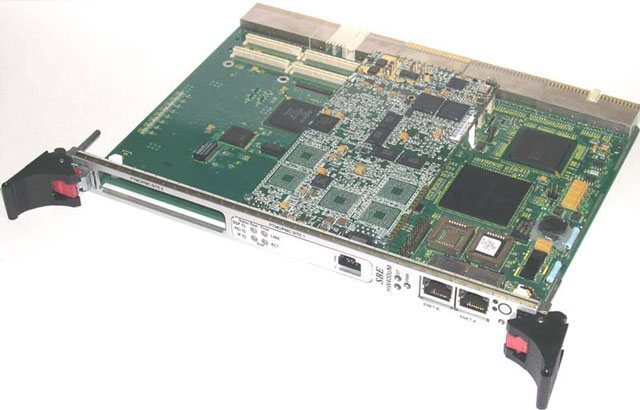
Desktop PC
Below are pictures showing the SigC5561-7x7-PTMC connected to active and passive adapters, enabling the SigC5561-PTMC to operate in a desktop PC as a standard PCI/PCIe card. An active adapter, including bridge device and voltage-level translation circuitry, allows the SigC5561-7x7-PTMC to be inserted into either 5V or 3.3V PCI slots. A passive adapter can be used for 3.3V-only PCI slots.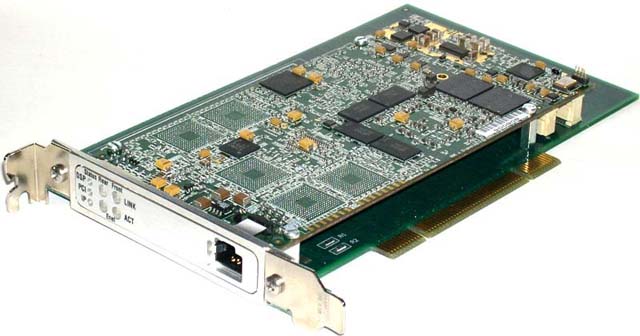 SigC5561-7x7-PTMC card installed on passive adapter for insertion in desktop 3.3V
PCI slot
SigC5561-7x7-PTMC card installed on passive adapter for insertion in desktop 3.3V
PCI slot
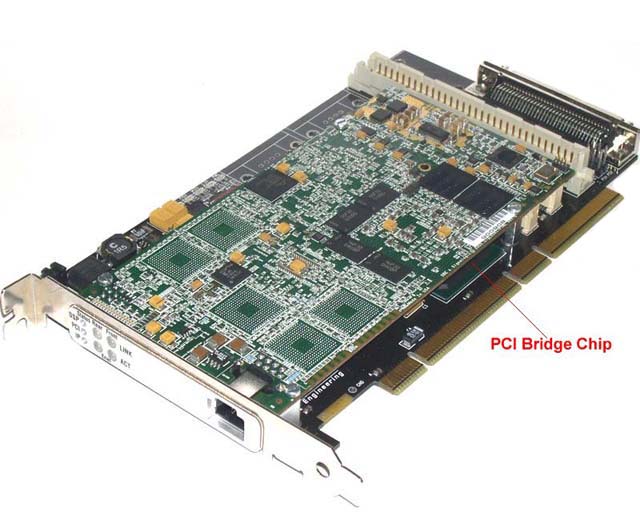 SigC5561-7x7-PTMC card installed on active adapter for insertion in desktop 3.3V or 5V PCI slot
SigC5561-7x7-PTMC card installed on active adapter for insertion in desktop 3.3V or 5V PCI slot
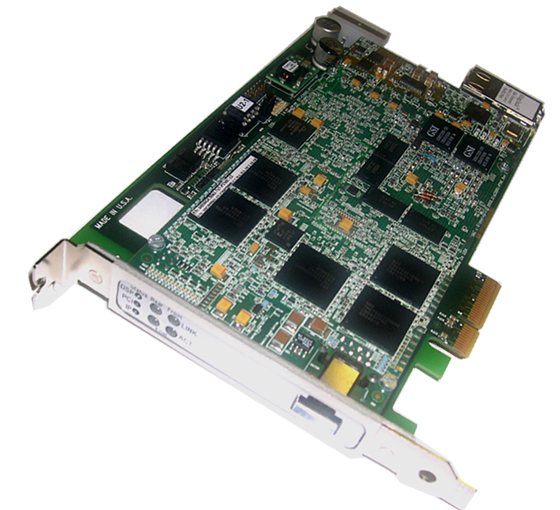 SigC5561-7x7-PTMC card installed
on active adapter for insertion in desktop 1.8V PCIe slot
SigC5561-7x7-PTMC card installed
on active adapter for insertion in desktop 1.8V PCIe slot



